
I'm not a big fan of the double-faced cards. I'm a primarily Limited player and they're awkward to draft. Even so, Innistrad is a design triumph. The card designs are clean and intuitive yet the Limited format they create is one of the best we've seen, period. In fact, one Innistrad card, Prey Upon, got me thinking. As green removal goes, this is perhaps the best that's ever been done. Its short rules text is completely grokkable, it fits the color pie, and it's playable but certainly not overpowered.
The way a friend of mine expressed that is, Prey Upon is in the platonic ideal of Magic.
A platonic ideal is the most basic essence of a class of objects, stripped of individuality to reveal the most core attributes. And to some extent, Magic 2010 showed us the platonic ideal of a Magic set. In M10 Wizards prioritized clean design, grokkability, and the use of flavorful keywords while significantly decreasing the actual amount of text printed on the cards.
I think M10 was excellent in that respect, but I also that Wizards has learned a lot since (and as a result). In particular Innistrad kicked it up a notch further, eschewing completely the use of purely mechanical keywords like cycling and kicker in favor of more flavorful designs (in its first implementation flashback was very mechanical but in Innistrad, where the graveyard theme is in synch with the set's flavor, I think it belongs much more). Furthermore, from a gameplay perspective Innistrad has showed significant progress over past sets; in no previous set (spare perhaps M12 with bloodthirst) have one-drops been so relevant. And while many cards in Innistrad are playable only in a specific draft archetype, there are relatively few Limited-unplayable commons.
Given the progress we've seen in the game since M10, and given that we've seen three modern core sets (and can hence backwards engineer an appropriate design skeleton) I thought it would be an interesting exercise to look at what might now be assembled as a platonic ideal Magic set.
What I'm going to do is talk about a few choice cards in each color that I think belong in core because they fit the platonic ideal of Magic. They'll be mostly commons, as the variance at higher rarities makes those slots less predictable, but I do look at a few cards at higher rarities that I think are particularly noteworthy.
This is a little weird for me since I'm pretty strongly a Melvin as opposed to a Vorthos. I like to think I have some grasp of flavor, and I do my best to prioritize it, but my choices will largely be made on the basis of mechanical cleanliness and grokkability.
Since green got me thinking about this project I'll start with that. You'll also notice that I talk about more cards in green than I do in any other color. This is no coincidence. I've always been a green player and feel most in tune with what that color wants to do.
Arbor Elf - Let's start off slow. I think Arbor Elf pretty plainly belongs in the core set over Llanowar Elves. First of all you've got that awkward plural in the name of Llanowar Elves, which was one nail in the coffin of Grizzly Bears. Beyond that Arbor Elf really conveys the feeling that the elves live in harmony with the forest and nurture it back to life when it's exhausted - and that an elf is diminished without a forest to live in. You don't even need Forests to run Llanowar Elves; in fact their inclusion in your deck will probably let you cheat on your green sources!
Prey Upon - This is what green removal should look like. In recent core sets we've seen green get a bad version of blue removal, a bad version of red removal, and a bad version of white removal. I guess Plummet, being a conditional outright kill spell, may even count as a bad version of black removal. Prey Upon really gives green its own identity as far as removal, something which each other color has, and something that each color needs in order for Limited to feel right. I don't know that it would be appropriate to use the fight keyword in core, but even written out this card is completely grokkable.
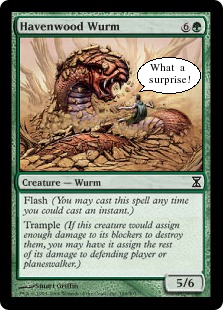
Vigilance is also a green mechanic we haven't seen in the core set, even though it's supposed to be in green. But the fact is that it's a lot harder for vigilance to be flavorful in green. Flash is easy; just look at how surprised that guy is in the art!
Viridian Emissary - The art is creepy and he's got a Phyrexian watermark so you're probably pretty skeptical on this one. But keep in mind that green is supposed to be the second best color at interacting with the graveyard. If we give this guy some new art, and flavor text like that of Sakura-Tribe Elder, he becomes downright reverent of nature and the cycle of life.

In terms of power level Ivy Elemental is certainly not out of line. While flexible, it's well below the curve in green at any cost. Green has always been allowed to get six power at common, sometimes seven, and it's very rare for a Limited game to get more lands on the table than that.
It's fine in terms of complexity as well. +1/+1 counters appeared at uncommon in M10 and common in M11 and M12; in each of the three sets there were even cards which repeatedly added the counters using triggered abilities!
Gelatinous Genesis - Wizards has also recently given us a pair of exciting X-cost rares in green, Gelatinous Genesis and Gensis Wave. Both are quadratic effects; the spell gets four times as good when you double the value of X. This seems deeply green to me. In addition, while Genesis Wave is a bit wordy, Gelatinous Genesis is admirable for being a swingy - sometimes outrageously so - card with only a single sentence of rules text.
Next up we'll look at red. Red it a bit tricky; it has few creature keywords and is often relegated to supporting color status in draft. The removal is splashable and the creatures don't stand up to comparison with other colors. While respecting the color pie, we'll see what we can do.
Tectonic Rift - Red is the worst at having evasive creatures. In fact, if you look at Standard right now the only evasive mechanic red gets on common creatures is three instances of trample - once conditionally and twice on one-power guys! To balance that out red gets effects like Panic Attack and Act of Treason to push through damage.
We need a spin off which is playable and flavorful. This is where Tectonic Rift comes in. Neither land destruction nor Panic Attack is particularly exciting at four but with both the card is at least playable. And at common, appearing sometimes in multiples, this card can keep your opponent off of their bombs while letting you push through significant damage. This is exactly what red, who probably had the early game advantage, wants to do.
Kiln Fiend - This guy is what you always wanted Chandra's Spitfire to be, and, as such, emphasizes red as a spell color (rather than a creature color). Red wants effects now; it doesn't want to invest in board position so it can swing later. Initially I thought that his playability might suffer from being printed in a set without rebound, but in fact Rise only had one red common with rebound - and since it was the top common in the set you weren't likely to get passed many of them. Your average core set also has notably more instants (as opposed to sorceries) compared to Rise.
Heat Ray - The spell "throw fire at that creature until it's dead, no matter how much fire I need to use" ought to be in every red mage's arsenal. This is in line with red's core mentality and should exist at common. Relatedly, red comes in a close second for kicker costs, with the other three colors considerably behind.
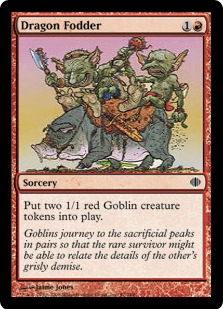
Rolling Thunder - Fireball is a deeply resonant name but the rules text just brings too much baggage. I wish for Rolling Thunder every time a new player tries to divide damage unequally or forgets to pay the additional cost on Fireball. Considering how similar they are mechanically, that probably just means that Rolling Thunder should take that place. Rolling Thunder may be rather more powerful than Fireball, which is already a strong first pick. But it's also less splashable, bringing it more in line with the other power uncommons.
Black was a little tricky because what we see in the core set is already a pretty good reduction of what we see in expert-level expansions. There are some creatures showing off black's core mechanics and a rotating cast of removal spells. Every year in the core set there are a few black cards that are obviously unplayable but it's less obvious what's missing.
Typhoid Rats - We've seen a common one-drop in black in each recent core set (the first being unplayable and the other two being tied in to the set's featured mechanic. That means if we want to have a black common one-drop suitable for a generalized core set we're going to need to start from scratch and look at black's core mechanics and keywords. Among evergreen keywords only a few can be used to make a one-drop relevant. Typhoid Rats has demonstrated that deathtouch is one of them.
Disfigure - Last Gasp or Grasp of Darkness could just as easily have had this spot mechanically, but Disfigure is just such a great name that I gave it the nod. Back in the olden days black removal was almost exclusively Terror-style. In recent years we've seen an increasing amount which uses other conditions, particularly size (I believe some time around Time Spiral it was acknowledged that this was because it's demoralizing to have your six-drops always answered for two mana). The core set has so far reflected this halfheartedly; Sorin's Thirst is nice but Wring Flesh and Stabbing Pain play more like combat tricks than outright removal.
Bone Splinters - This card is great. I take one of my guys and actually blow him up to kill your guy! I think it's appropriate at common despite its similarity to Goblin Grenade, a core set uncommon. Most notably Bone Splinters is easier to use (since you can sacrifice anything) and it's less likely to be a blowout (as it can't go to the dome).
One concern in the core set is that new players don't like cards which have a downside, which this does. It may be mitigated slightly by how obvious it is that you can trade up, blowing up a Zombie to kill their Dragon. It's also probably the case that anyone with a working knowledge of card advantage is also experienced enough to evaluate the power level of this card.
Brain Weevil - A few years back fear was phased out in favor of intimidate. We've seen it used here and there, mostly in black, and often in ways which are flavorful yet unplayable. So far the creatures which have intimidate by themselves are pretty complicated; we've yet to see anything like a plain old Severed Legion or Dread Warlock. Given the choices I think Brain Weevil is the best (so far) way to get intimidate into the core set. It's not great, particularly without morbid cards to power up, but it's playable. And I think the obvious flavor helps to mitigate the relatively high complexity for a core set common.
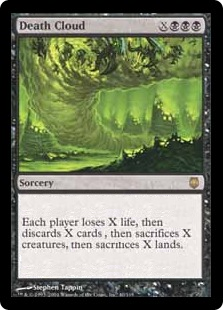
Blue was the trickiest color to come up with. Blue has a large portion of the color pie, it's true. But we also haven't seen much in the way of new blue mechanics. While other colors grow and flesh out their segments of the color pie, Wizards has been actively reining blue back. Blue's core mechanics have all been implemented a thousand different ways; the simple spells to bounce, counter, draw, tap, and mill are already in the core set!
Spell Blast - Conditional counterspells are all the rage now, being printed about twice as often as hard counters. But for some reason this particular spell, which was once printed all the time, has fallen out of favor. It seems intuitive that it would take more effort to counter a giant Fireball than a little Lightning Bolt, and nothing demonstrates that more cleanly than this.
It would alternatively be nice to see a variable "counter unless they pay X" spell in the core set. I can't give you the card name, though, because that mechanic has never been printed without bells and whistles tacked on. To me the flavor of a counterspell is that you're using willpower to stop their spell from resolving. Shouldn't that be easier if they're tapped out? And shouldn't my willpower be stronger as I have a greater amount of mana at my disposal?
Kraken Hatchling - Similarly to black, blue always gets a one-drop creature. In M10 and M11 they were bad. In M12 we got Phantasmal Bear. He's fine in Limited and sees Constructed play. He also makes sense in the context of the vertical Illusion cycle we saw in M12. But I don't think he belongs in a general core set.
The skulking/illusion mechanic has been blue for a while, and appeared in every recent core set. But it's usually used to get undercosted medium-to-large creatures (much like the skaab mechanic in Innistrad - compare Phantom Beast and Illusionary Servant to Makeshift Mauler and Stitched Drake). These are the kinds of guys that blue likes to throw down to make the opposing weenie horde stop in its tracks. The problem is that Phantasmal Bear would really just rather be part of the weenie horde; his job is to drop on turn one and turn sideways.
In the last few years we've seen an increasing number of Limited games defined by 2/2 creatures turning sideways. Blue (with the obvious exception of Phantasmal Bear) isn't great in that respect, and from a flavor perspective really isn't interested in getting in on the action. Blue would much rather just throw down a Kraken Hatchling and chill behind it for a few turns while casting the spells it's actually good at.
Sea Monster - Blue regularly gets a big guy in the core set, usually some kind of Serpent. It's aquatic, so it can't fight anything that's far away from the water. And sure, there are cute ways you can express that. But really, not being able to attack unless they control an Island explains what's going on just fine. With Harbor Serpent that extra ability makes the card a little better against opponents who aren't packing Islands but it's still no great shakes. Plus it's not doing much for the flavor. If I have five Islands, what, I open a chain of resorts so my opponent will go surfing?
In blue the win condition has always been flyers. Attacking with a Serpent is nice once in a while, but it's really just there to eat attackers while you win in the air. I don't see a reason to jump through any hoops here.
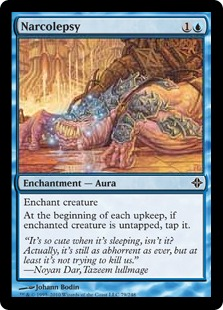
The last color we'll look at is white. White has so many creature keywords that I had to pass on the low-hanging fruit. Voiceless Spirit, Nightguard Patrol, and Diving Griffin are great examples of what white wants in a creature, and maybe they'll make it into a core set some day, but that's not particularly interesting.
Rebuke - Every color gets a certain flavor of removal. White, where the removal is usually framed as coming from some moral authority, makes sure the removal is "fair"; it's typically either non-lethal or somehow justified. The most obvious justification for killing something, of course, is self defense. And there's no clearer way to show that than by snuffing an attacker. Divine Verdict comes close but it always felt awkward to be able to kill a blocker defending his home from ravaging invaders; I think this is a clear step up.
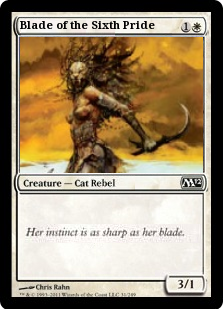
Village Bell-Ringer - As I mentioned before, I think we'll ultimately see Wizards realize that flash belongs in the core set. Furthermore, white always has some commons to demonstrate teamwork; M10 had Veteran Armorsmith and Swordsmith, M11 had Infantry Veteran and Squadron Hawk, and M12 has Griffin Rider. Village Bell-Ringer is a very flavorful way to fill both roles, who on top of that has the added bonus of being a virtual vanilla (something which appears with some frequency in the core set).
It's also cute that Village Bell-Ringer is so loud that he can even wake up someone who is asleep.
Liberate - I'm not crazy about the name here; I would reconcept this as hiding the creature. But be that as it may this is an ability that's fallen in white for a long time and which has never seen the light of day in a core set. This card allows white to protect its creatures (filling the Safe Passage/Stave Off slot) while also enabling cute interactions with enter-the-battlefield effects. I considered instead putting a blink effect in this spot - returning immediately instead of at end of turn - but that card would be simultaneously harder to concept, worse at protecting from non-targeted removal, and more likely to cause blowouts in combat (and as such would probably not be common).
Fiend Hunter - This card is just about perfect. The art, the name, and the rules text mesh perfectly. It's also the perfect implementation of temporary removal. The thing isn't dead; I've just had my man tie it up to keep it out of trouble! I would just swap Oblivion Ring right out for this at uncommon in the core set. Don't get me wrong - I like Oblivion Ring a lot - putting a face on it just makes the flavor much more resonant.
For that last one I'll bet you thought I was going to bring up Hail of Arrows!
I hope you had fun joining me in this exploration of what we may see become the core of Magic. What did I miss? What am I way out of line on? I'll be excited to see in the forum what you guys think!
Comments